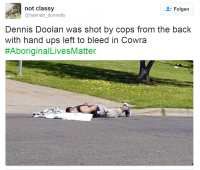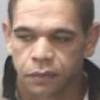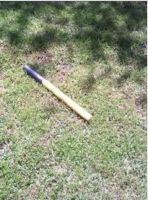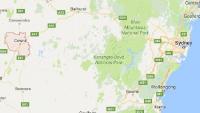An Aboriginal man shot by police in the Australian outback town of Cowra could struggle to walk again, his family says. Thirty-two-year-old old Dennis Doolan has been in an induced coma since police shot him in a buttock in the central New South Wales town last Wednesday morning (28 September). Police say Doolan was wanted for questioning over an aggravated robbery. Hospital doctors say he is recovering. But they have warned him he will have some tough decisions to make when he regains consciousness, because removing the bullet from his hip could leave him with walking difficulties.
Conflicting reports have emerged about the incident, which occurred in a suburban street, and has worsened existing racial tensions in the town. A number of photographs have been posted to social media.
A police source told ABC radio that Doolan was allegedly moving towards a female officer with the wooden handle of a garden implement (pictured below) when he was shot, and that he had allegedly threatened officers with shards of broken crockery and a screwdriver.
Doolan’s cousin took a photo of the scene in the moments before the gun was fired, saying he was unarmed at the time. He posted two images on Facebook, with the caption: "Pure racism at its finest”. Photos taken by onlookers of police apparently shooting Doolan have appeared in mainstream media reporting. But police say a photo circulating on social media was of earlier pursuit, not the shooting.
The aboriginal community in Cowra is very angry at the incident. Witnesses confronted police, with one man saying "You didn't have to shoot him." "They never tasered him or pepper sprayed him — nothing," said one witness. "Like a mongrel dog sitting on the road. He was crying in agony and pain, and they wouldn't pick him up."
A witness to the shooting claims Doolan was about to run away from police officers and had discarded a wooden weapon – probably the shaft of a gardening tool or of an axe - moments before he was shot. Police say he was also armed with a screw driver. Another witness told a newspaper reporter that Doolan smashed a plate and ran at police with a screwdriver and then again with the handle of an axe. The axe did not have a blade.
Many on social media are disappointed that the story has not made bigger headlines and angry at what they see as another example of police brutality, in a country where institutional violence and incarceration overly impact Indigenous people to near epidemic levels.
Extra police were rushed into Cowra from two other towns in the region because of concerns voiced by residents that the shooting could escalate racial tensions already present in the viticulture town of 9,700 people, located 310 km southwest of Sydney. In the 2011 census 6.5% of the Shire of Cowra population identified themselves as indigenous. Police are working with community leaders to try to defuse tensions.
Dennis Doolan's cousin, Joshua Simpson, said he is worried the shooting will create tension between police and the local Indigenous community. "There's been tension between the police and the Aboriginal community in this town for years," he said.
"There's been steps to break down those walls and those barriers but when things like this happen it's not doing nothing for the reconciliation in the town. More steps need to taken, especially when there's things like this."
Mr Simpson said his cousin was unfairly targeted. "An unarmed man, arms in the air, willing to surrender, and then shot."
Dozens of Doolan’s relatives shouted at police "black lives matter!" and "this is not America!".“To the police, you better watch yourselves cause you started this war,” one local woman told a television crew.
A critical incident team will investigate the incident, including the discharge of a police firearm, before an independent review.
The shooting followed shortly after the release of figures showing that the number of indigenous prisoners has more than doubled since 2001, despite indigenous arrest rates for violent and property offences falling by about a third over this time.
Analysis published by the NSW Bureau of Crime Statistics and Research suggested the increase in the indigenous prison population may be the result of changes in police policy and tougher sentencing in the courts.
“Where once they would have been arrested for property and violent crime, they are now being arrested for other types of crime, particularly where police go looking for them,” the bureau’s director Don Weatherburn said.
The bureau’s research suggests indigenous people were now more likely to be arrested for breaching court orders, such as AVOs, or for assault and intimidation-related offences, Mr Weatherburn said.
Overall, indigenous people in NSW were six times more likely to be arrested for any offence than non-indigenous people, and they represented a disproportionately high percentage of the prison population.“There is a moral or an ethical dimension to this, in the sense that we obviously can’t rely on falling crime rates alone to reduce Aboriginal imprisonment,” Mr Weatherburn said.
A new approach to tackling crime rates by investing in community programmemes rather than prison beds is being considered for Cowra, where a study analysed the potential benefits of "justice reinvestment".
Those behind the Cowra proposal have been spurred on by a report about the existing justice reinvestment programme running at Bourke in far western NSW. They are now hoping for state funding to be spent on programmes to prevent crime, arguing that the money would be a fraction of what it was costing to send local people to jail.
Justice reinvestment has been used in places such as the US state of Texas, where proponents say its success could be seen in a fall in the prison population.
Australian National University (ANU) Research Fellow Jill Guthrie, described it as taking the focus and funding off incarceration and into intervention. "It's the political will by governments not to spend money on new prison beds but rather to bring that money up to the front end: things like community development and early education," Guthrie, who is of Wiradjuri Aboriginal descent from Cowra, said.





Second Indigenous man shot by Australian police in days
Police have shot an Indigenous man after an alleged altercation in Broome, Western Australia, on Monday night. Police said a 66-year-old man from the remote Indigenous community of Balgo had been shot by a police officer after the alleged altercation “between a number of offenders, one of whom was armed with a knife”.
He had allegedly been travelling in a taxi with two women and had an argument with the driver. Police claimed the man had earlier threatened the taxi driver with the knife and had stabbed the taxi’s tyres several times before police arrived.
Click here for other media’s reporting of this incident.
Recently here on Indymedia
Declaration of Yuggera tribal sovereignty to the lands of Brisbane/Ipswich
Time to pick up the pace for decolonisation for First Nations Peoples in Australia – departing for London
Children removed from families are at highest risk to suicide
Australia continues its nuclear war against Aborigines
Australia must recognise it has a race relations problem, to move forward on reconciliation
An Aboriginal prisoner has died after brawling with five guards
South Australia: Anti-nuclear camp out and rally in the Flinders Range 7-9 October
Call by Aboriginal rugby stars to snub the Australian anthem
More blah or real chances of progress for Australia’s indigenous peoples?
Another court challenge to Australia's biggest coal mine plan
Kalgoorlie Uprising: Black Man’s Victim. White Man’s Culprit, And The Twisted Psychology Of Racially Motivated Crime and Punishment
Australian psychologists apologise to Aborigines and Torres Strait Islanders
The Custody Notification System saves Aboriginal lives. Why isn't it national?
We are under occupation by a foreign power, which keeps us in our place by superior force
One in 10 young Australian Indigenous men rate their happiness at 'zero'
“Galilei got it wrong, the Yolngu got it right” about tides
Senate tells Australian government not to fund controversial coal mine